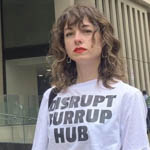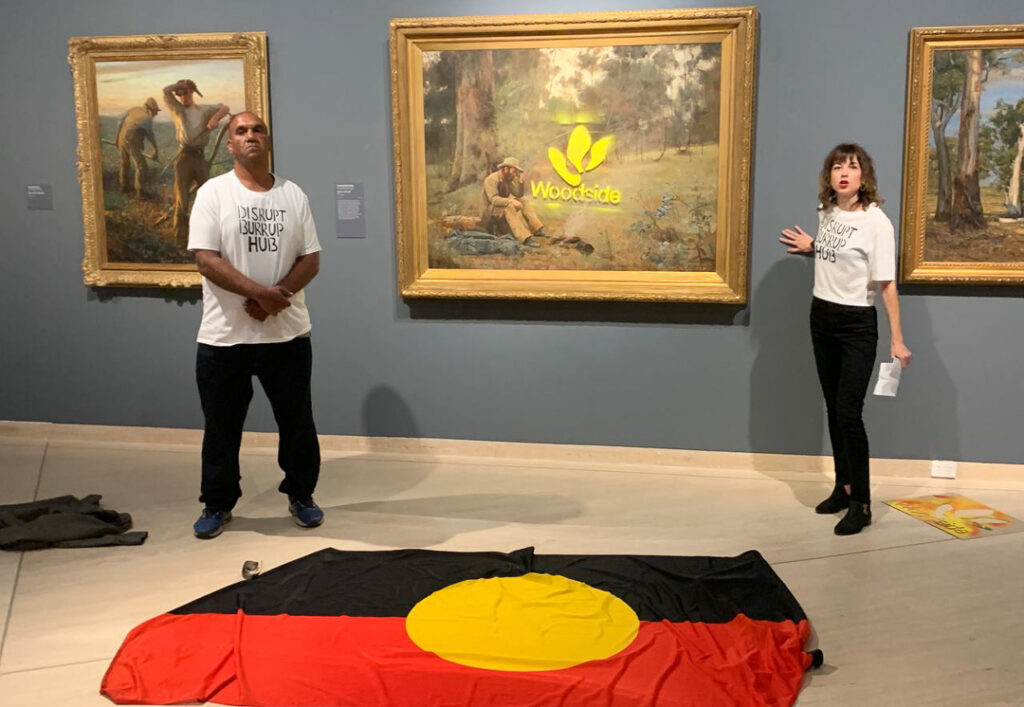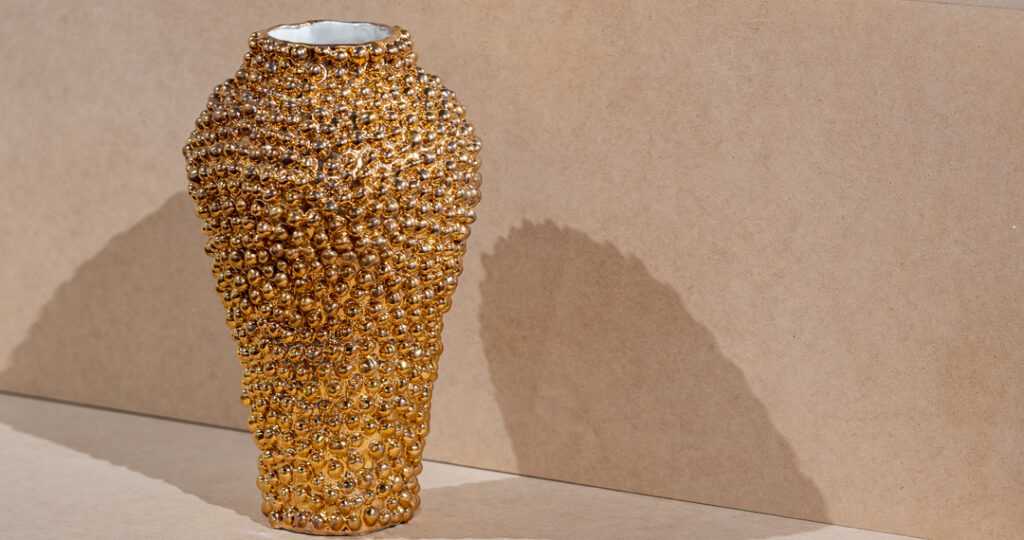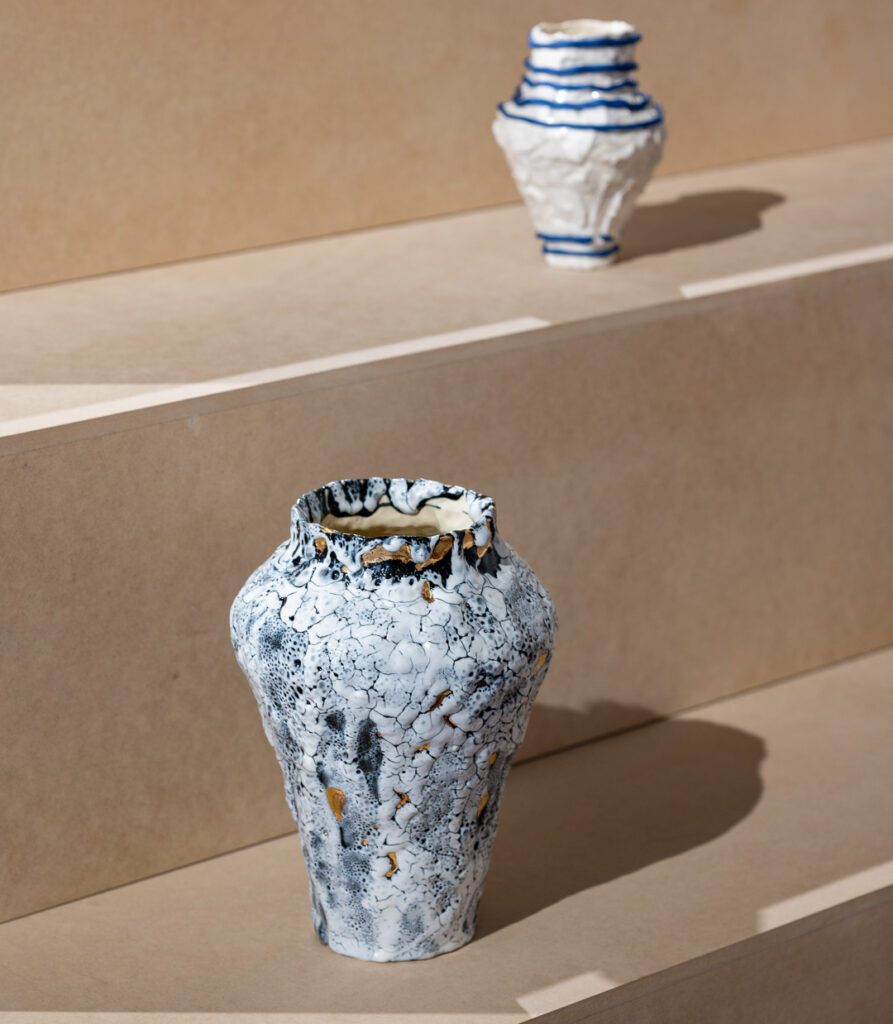Joana Partyka explains the paradox of making expressionist ceramics while also defacing masterpieces to highlight the damage of fossil fuel projects.
(A message to the reader.)
The process of coil-building a ceramic vessel is exactly as it sounds: I roll a lump of clay into a long snake—not unlike rolling out gnocchi—and attach that snake to a clay base I’ve made. I pinch and pull the clay into shape as desired. I then repeat that process until I have a finished vessel built from the bottom up.
I use the term “finished” loosely because it’s actually just the beginning. I must then bisque-fire the vessel in preparation for glazing, and then glaze and fire the piece itself—sometimes up to five times. I often cap off the process with an overglaze firing, which imparts the piece with a lustrous metallic finish.
The end result is, frankly, quite ugly. Pseudo-naive. Anti-aesthetic. Clumps, drips, gloops, cracks: my ceramics are not traditional by any means, nor are they to everyone’s liking. Often I don’t even like them myself.
My relationship with the ceramic medium itself is equally conflicted. On the one hand, it’s pure joy: transforming infinite combinations of finely milled minerals into a carnival of glaze textures and colours; turning the contents of my turbulent insides into a tangible something that exists outside; sinking into calm as I sink my fingers into a yielding lump of earth.
The flip side bears the difficult truth that this earth and these minerals are pillaged from sovereign Country
The flip side bears the difficult truth that this earth and these minerals are pillaged from sovereign Country; that the process of transmuting my insides outside is energy-intensive in more than just the patience it demands of me. Through my art practice, I find myself complicit in the destruction and degradation of the earth I work to defend as a climate activist, which in turn is a subject I often interrogate through my art practice.
Within this very paradox—hypocrisy, perhaps—lies a key reason I make ceramics. By way of medium alone, the work becomes a poignant reflection on the complexities of our sapien interaction with the natural world. Both as an artist and as a species, we must learn to accept that the act of creation—which at its core is the pursuit of beauty—is never absent of destruction. At times, the destruction is the beauty.
✿
It was a regular Thursday in January last year. I made a visit to the Art Gallery of Western Australia, wandering deep into its cavernous belly and pausing sporadically to examine interesting brushstrokes and striking palettes.
Then I approached Frederick McCubbin’s 1889 painting Down on his luck and spray painted the Woodside Energy logo directly onto it.
My action drew widespread support, but the chorus against it was loud. “Why can’t they leave the art alone?” 2GB’s Deborah Knight lamented on air. “It’s totally inappropriate,” said then WA Premier Mark McGowan. Darren McCubbin, a direct descendant of the artist, argued that acts like mine normalised “using artwork not as artwork but as some kind of ridiculous tool”.
Around the world this specific form of activism—defacing iconic artworks to bring attention to a cause—draws similar reactions. In response to a November 2022 protest targeting a Van Gogh in Rome, Italy’s culture minister said art “should not be used as a megaphone for other forms of protest”. Barcelona’s Egyptian Museum, meanwhile, defended museums as “spaces for critical reflection” after a protest on its premises that same month.
Distilled down, these missives are largely variations on one theme: keep your activism off our Impressionism.
In other words, art galleries are not appropriate sites for protest.
In other words, art has nothing to do with politics.
On Western Australia’s Burrup Peninsula, art and politics could not be more intertwined. The area known as Murujuga to Traditional Custodians is home to the oldest and largest collection of Aboriginal rock art in the world—50,000 years and up to two million respectively. A deeply sacred place of astounding historical and archeological significance, it was nominated last year for UNESCO World Heritage status.
Quite literally down the road is a patchwork of huge industrial facilities, many of them owned or operated by Woodside. Acidic emissions from these facilities are eroding Murujuga’s rock art as we speak. Experts agree it faces total destruction within decades.
The aggravating factor at play is Woodside’s Burrup Hub mega-development. If fully realised, the Burrup Hub will pump out six billion tons of deadly CO2 into our atmosphere over the next 50 years. That’s more than 13 times’ Australia’s total current annual carbon emissions, giving the Burrup Hub the dubious title of Australia’s most polluting new fossil fuel project up for approval.
At a time when we know the existence of our and all other species relies on a rapid transition out of fossil fuels, the Burrup Hub is downright criminal.
As so many who came before me have known, such egregious misdeeds of the state can’t be overcome by obeying the laws that create them in the first instance. And as so many who came before me have shown, cultural capital makes for a powerful target.
In 1914, suffragette Mary Richardson smuggled a meat cleaver into London’s National Gallery and slashed the canvas of Diego Velázquez’s Rokeby Venus. Months later, her compatriot Anne Hunt repeated the tactic on a painting at the National Portrait Gallery. These were just two actions in the long and sometimes bloody campaign to win women in the UK the right to vote, which would take another 14 years to fully achieve.
Hatchet fiend, militant, wild woman. Art thug, extremist, stupid slut. Obloquies directed at activists in 1914 are nearly identical to those flung at me 110 years later, as is the urge of some critics to share their opinion that we should be drowned.
While abuse of this nature is clearly abhorrent, it is nothing more than a misplaced expression of fear. What is so clear to the activist is unseen by the rest of us; the thundering call to fundamentally change the world as someone knows it is a potent defence trigger.
Activism is thus an outstanding social bellwether. The stronger the public response—disgust, rapture, loathing—the stronger the likelihood it is heading down the right track.
Of course, we cannot know that for certain in the moment. It is solely the passage of time that can clarify the prescience of those we demonise today.
- Joana Partyka Thunderbox, 2022 stoneware, glaze, lustre 28 x 15cm; photo: Miles Noel Photography
- Joana Partyka, from PICA Out of Bounds; photo: Miles Noel Photography
Throughout history, art has been a cosy bedfellow to activism. Protests, revolutions and social movements around the world have relied on art to flourish and transform: take, for instance, the power of gospel music in the American civil rights movement.
It is precisely because art is a tool that activists use it to get their message out. It is because museums are spaces for critical reflection that they have become a magnet for activism.
For two activities so outwardly dissimilar, art and activism are so exquisitely in service of the same end. They both aim to engage people; to communicate a message or to pose a question. To invite people to think of things in a different way, or to think of them at all.
At their respective hearts, their purpose is to make the world more beautiful.
The day after Mary Richardson’s attack on the Rokeby Venus, the press published her written statement. “Justice is an element of beauty as much as colour and outline on canvas,” she wrote.
The howling outrage born of that yellow Woodside logo splashed over McCubbin’s melancholic settler, the angry messages from strangers advising me of my artistic ineptitude: they are unlikely messengers of beauty. They’re a sign I’m on the right track.
About Joana Partyka
 Joana Partyka (she/her) is an artist, activist and writer based in Boorloo/Perth. Working primarily in ceramics, Joana’s work is deeply informed by the political context and aims to push the boundaries of the medium. She has exhibited in galleries around Australia including Flinders Lane Gallery, Modern Times and the Perth Institute of Contemporary Art (PICA). Joana is an active climate campaigner who in 2023 spray-painted the Woodside logo onto Frederick McCubbin’s Down on his luck at the Art Gallery of WA, highlighting the company’s destruction of our climate and desecration of culture. Visit joanapartyka.com and follow @joanapartyka.
Joana Partyka (she/her) is an artist, activist and writer based in Boorloo/Perth. Working primarily in ceramics, Joana’s work is deeply informed by the political context and aims to push the boundaries of the medium. She has exhibited in galleries around Australia including Flinders Lane Gallery, Modern Times and the Perth Institute of Contemporary Art (PICA). Joana is an active climate campaigner who in 2023 spray-painted the Woodside logo onto Frederick McCubbin’s Down on his luck at the Art Gallery of WA, highlighting the company’s destruction of our climate and desecration of culture. Visit joanapartyka.com and follow @joanapartyka.





Comments
SHAME, SHAME, SHAME on you. You create with one hand and destroy with the other. It is you who are the paradox. Two wrongs do not make a right.